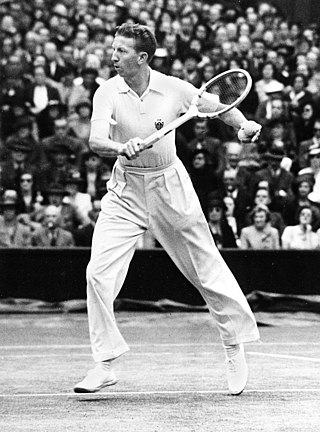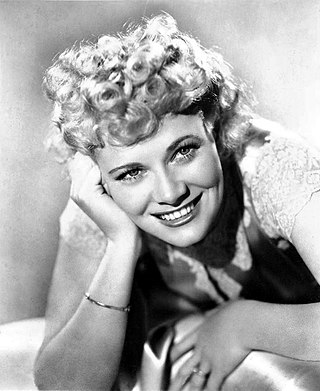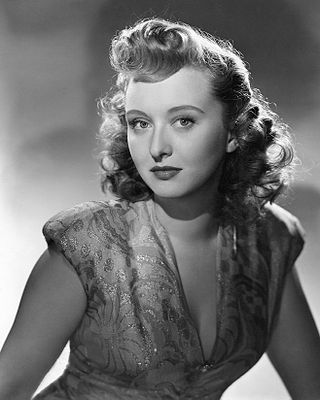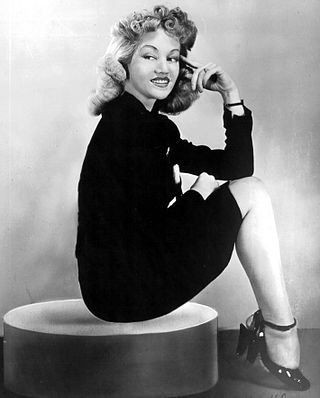Related Research Articles

John Donald Budge was an American tennis player. He is most famous as the first tennis player — male or female, and still the only American male — to win the Grand Slam, and to win all four Grand Slam events consecutively overall. Budge was the second man to complete the career Grand Slam after Fred Perry, and remains the youngest to achieve the feat. He won ten majors, of which six were Grand Slam events and four Pro Slams, the latter achieved on three different surfaces. Budge is considered to have one of the best backhands in the history of tennis, with most observers rating it better than that of later player Ken Rosewall.

Penny Singleton was an American actress and labor leader. During her 6 decade career on stage, screen, radio and television, Singleton appeared as the comic-strip heroine Blondie Bumstead in a series of 28 motion pictures from 1938 until 1950 and the popular Blondie radio program from 1939 until 1950. Singleton also provided the voice of Jane Jetson in the animated series The Jetsons from 1962 to 1963.

Clara Lou "Ann" Sheridan was an American actress and singer. She is best known for her roles in the films San Quentin (1937) with Humphrey Bogart, Angels with Dirty Faces (1938) with James Cagney and Bogart, They Drive by Night (1940) with George Raft and Bogart, City for Conquest (1940) with Cagney and Elia Kazan, The Man Who Came to Dinner (1942) with Bette Davis, Kings Row (1942) with Ronald Reagan, Nora Prentiss (1947), and I Was a Male War Bride (1949) with Cary Grant.

Constance Campbell Bennett was an American stage, film, radio, and television actress and producer. She was a major Hollywood star during the 1920s and 1930s; during the early 1930s, she was the highest-paid actress in Hollywood. Bennett frequently played society women, focusing on melodramas in the early 1930s and then taking more comedic roles in the late 1930s and 1940s. She is best remembered for her leading roles in What Price Hollywood? (1932), Bed of Roses (1933), Topper (1937), Topper Takes a Trip (1938), and had a prominent supporting role in Greta Garbo's last film, Two-Faced Woman (1941).

Celeste Holm was an American stage, film and television actress.

Gale Page was an American singer and actress.

Rita Ann Johnson was an American actress.

Lucile Watson was a Canadian actress, long based in the United States. She was "famous for her roles of formidable dowagers."

Jean Rogers was an American actress who starred in serial films in the 1930s and low–budget feature films in the 1940s as a leading lady. She is best remembered for playing Dale Arden in the science-fiction serials Flash Gordon (1936) and Flash Gordon's Trip to Mars (1938).

Robert Wesley Addy was an American actor of stage, television, and film.

Mary Alice "Maris" Wrixon was an American film and television actress. She appeared in over 50 films between 1939 and 1951.

Paula Stone was an American theater and motion pictures actress from New York City.

Robert Larimore Riggs was an American tennis champion who was the world No. 1 amateur in 1939 and world No. 1 professional in 1946 and 1947. He played his first professional tennis match on December 26, 1941.

Selena Royle was an American actress of stage, radio, television and film and later, an author.

Anita Ellis was a Canadian-born American singer and actress. She famously dubbed Rita Hayworth's songs in Gilda.

Bernadene Hayes was an American film and television actress. She also performed on radio and the stage, and as a singer.

Elspeth Thexton Eric was an American actress in old-time radio, "usually cast as the other woman in soaps and serials".

Charlotte Manson was an American radio actress whose career was interrupted by paralysis.

Lou Swarz was an American actress who performed monologues in one-woman shows and featured in films during the 1930s through the 1950s. Her success drew an invitation from Eleanor Roosevelt to the summer White House. She also hosted radio shows and hosted performances at the 1939 New York World's Fair. She was also a teacher of theatre and beauty at Douglass University and other vocational schools, before becoming a sports columnist for The New York Age and having several syndicated columns.

Eula Moulder Morgan was an American opera singer and actress in films and theater from the 1930s through the 1950s. A professional pianist during her childhood, she practiced studying opera as a career in her adult years, performing in theatres across multiple states. Her first film role was in The Great American Broadcast in 1941 and she would have a number of appearances in films in the decade after, prominently in roles that featured her singing operatic solos.
References
- ↑ "New York, U.S., State and Federal Naturalization Records, 1794-1943". Ancestry. Retrieved 5 January 2024.
- 1 2 "Tommy Riggs Marries Actress" . The New York Times. June 11, 1948. p. 20. Retrieved July 12, 2023.
- 1 2 3 4 Sher, Jack (July 23, 1939). "New York Reporter: Who . . . What . . . When . . . Where". Press of Atlantic City. p. 20. Retrieved July 22, 2023– via Newspapers.com.
- ↑ Lindsay, Patricia (April 2, 1940). "Radio Actress Has Strict Health and Beauty Routine". The Tampa Times. p. 14. Retrieved July 27, 2023– via Newspapers.com.
- 1 2 "Radio Actress". Springfield News-Sun. December 25, 1938. p. 13. Retrieved July 22, 2023– via Newspapers.com.
- ↑ "Tom Riggs Weds Actress in Easton". Pittsburgh Post-Gazette. June 11, 1948. p. 11. Retrieved July 27, 2023– via Newspapers.com.
- ↑ Dunning, John (May 7, 1998). On the Air: The Encyclopedia of Old-Time Radio. Oxford University Press. p. 717. ISBN 978-0-19-977078-6 . Retrieved July 22, 2023.
- ↑ "Beauties Face Network Microphones". The Akron Beacon Journal. February 4, 1940. p. 21. Retrieved July 27, 2023– via Newspapers.com.
- ↑ "Radio Actress". Springfield News-Sun. June 4, 1939. p. 15. Retrieved July 27, 2023– via Newspapers.com.
- ↑ Lesser, Jerry (May 16, 1942). "Radio Talent: New York". Billboard. p. 9. Retrieved July 22, 2023.
- ↑ "Radio 'Pretties'". Des Moines Tribune. January 18, 1939. p. 11. Retrieved July 22, 2023– via Newspapers.com.
- ↑ "Tommy's Betty Lou To Get Stepmother". The Pittsburgh Press. June 5, 1948. p. 1. Retrieved July 27, 2023– via Newspapers.com.
- ↑ "Purely Personal". Motion Picture Daily. October 22, 1937. p. 2. Retrieved July 27, 2023.
- ↑ "Town, Gown Actress Now On TV Program". Birmingham Post-Herald. April 21, 1954. p. 9. Retrieved July 27, 2023– via Newspapers.com.
- ↑ Hawes, William (March 15, 2001). Live Television Drama, 1946-1951. McFarland. p. 237. ISBN 978-0-7864-0905-1 . Retrieved July 22, 2023.
- ↑ "Broadway". Variety. September 4, 1946. p. 55. Retrieved July 27, 2023.
- ↑ "Surprise Wedding". Chicago Tribune. 23 February 1940. Retrieved 5 January 2024.
- ↑ "New York, New York, Index to Marriage Licenses, 1908-1910, 1938-1940". Ancestry. Retrieved 5 January 2024.